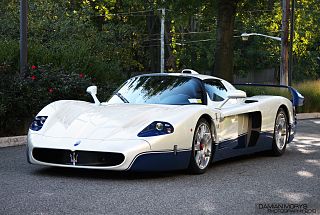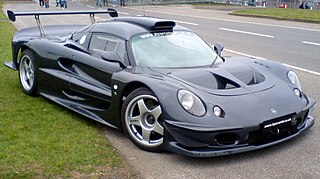
TVR is a British manufacturer of sports cars. The company manufactures lightweight sports cars with powerful engines and was, at one time, the third-largest specialised sports car manufacturer in the world, offering a diverse range of coupés and convertibles.

The Lamborghini Diablo is a high-performance mid-engine sports car built by Italian automobile manufacturer Lamborghini between 1990 and 2001. It is the first production Lamborghini capable of attaining a top speed in excess of 320 kilometres per hour (200 mph). After the end of its production run in 2001, the Diablo was replaced by the Lamborghini Murciélago. The name Diablo means "devil" in Spanish.

The Porsche 911 GT1 is a car designed and developed by German automobile manufacturer Porsche AG to compete in the GT1 class of sportscar racing, which also required a street-legal version for homologation purposes. The limited-production street-legal version developed as a result was named the 911 GT1 Straßenversion.

The Maserati MC12 is a limited production two-seater sports car produced by Italian car maker Maserati to allow a racing variant to compete in the FIA GT Championship. The car entered production in 2004, with 25 cars produced. A further 25 were produced in 2005 after the FIA changed the rules and reduced the maximum length allowed. The second batch of 25 are 150mm shorter than the originals, making a total of 50 cars available for customers. With the addition of 12 cars produced for racing, a total of just 62 were ever produced.

The Aston Martin DBR9 is a racing car built by Aston Martin Racing, debuting in 2005 and racing actively in international sportscar racing until the end of GT1 category in 2011. The name DBR9 is derived from the original 24 Hours of Le Mans-winning DBR1 car, named for then-owner David Brown, which not only won the 24 Hour race in 1959 but also the World Sportscar title. The car is most famous for taking two LMGT1 class wins at Le Mans 24 Hours by the Aston Martin Racing factory team.

The Porsche 911 GT3 is a high-performance homologation model of the Porsche 911 sports car. It is a line of high-performance models, which began with the 1973 911 Carrera RS. The GT3 has had a successful racing career in the one-make national and regional Porsche Carrera Cup and GT3 Cup Challenge series, as well as the international Porsche Supercup supporting the FIA F1 World Championship.

The Chevrolet Corvette (C6) is the sixth generation of the Corvette sports car that was produced by Chevrolet division of General Motors for the 2005 to 2013 model years. It is the first Corvette with exposed headlamps since the 1962 model. Production variants include the Z06, ZR1, Grand Sport, and 427 Convertible. Racing variants include the C6.R, an American Le Mans Series GT1 championship and 24 Hours of Le Mans GTE-Pro winner.

The USF Pro 2000 Championship Presented by Cooper Tires, formerly known as the Star Mazda Championship, Pro Mazda Championship, and later Indy Pro 2000 Championship, is an open-wheel racing series serving as the third step on the Road to Indy ladder system, between the U.S. F2000 Championship and Indy NXT. The series is sanctioned by the United States Auto Club and operated by Andersen Promotions. The series' champion is awarded a scholarship package to advance to Indy Lights competition for the following season. It competes on all open-wheel disciplines: road courses, street courses, and ovals.

The Mercedes-Benz CLK GTR is a GT1 sports car built and produced by Mercedes-Benz in conjunction with their then motorsport partner AMG. Intended for racing in the new FIA GT Championship series in 1997, the CLK GTR was designed primarily as a race car. As such, the production of road cars necessary in order to meet homologation standards of GT1 was a secondary consideration in the car's design, i.e. the CLK GTR was a homologation special.

The TVR Cerbera Speed 12, originally known as the Project 7/12, is a sports car designed by TVR in 1997. Based on the TVR Cerbera, the vehicle was intended to be both the world's fastest road car and the basis for a GT1 class endurance racer. However, problems during its development, changing GT1 class regulations and the eventual decision that it was simply incapable of being used as a road car forced TVR executives to abandon its development.

The McLaren F1 GTR is the racing variant of the McLaren F1 sports car first produced in 1995 for grand touring style racing, such as the BPR Global GT Series, FIA GT Championship, JGTC, and British GT Championship. It was powered by the naturally aspirated BMW S70/2 V12 engine. It is most famous for its overall victory at the 1995 24 Hours of Le Mans where it won against faster purpose-built prototypes in very wet conditions. The F1 GTR raced internationally until 2005 when the final race chassis was retired.

The Lotus Elise GT1 is a race car developed for grand tourer-style sports car racing starting in 1997.

The Chevrolet Corvette C6.R is a grand tourer racing car built by Pratt Miller and Chevrolet for competition in endurance racing. It is a replacement for the Corvette C5-R racing car, applying the body style of the new C6 generation Chevrolet Corvette as well as improvements to increase the speed and reliability on the track. Since its debut in 2005, it has continued on from the previous dominance of the C5-R in its racing class with multiple American Le Mans Series championships and race wins in the Le Mans Series, FIA GT Championship, and 24 Hours of Le Mans. There are two main versions of the Corvette C6.R: the GT1 version which has 590 HP, carbon-ceramic brakes, and aggressive aerodynamics, and the GT2 version which has 470 HP, cast-iron brakes, and relatively stock aerodynamics with respect to the road car. Unrestricted though, the LS7.R engine will produce around 800 hp. By 2012 the C6.R GT1 was retired from the competition while the GT2 version continues to race around the world.

Jamie Oliver Campbell-Walter is a British professional racing driver. He was born in Oban, Scotland on 16 December 1972. He won the FIA GT Championship in 2000 and took a World Endurance Championship title in 2013 as an Aston Martin Racing factory driver. He now owns and runs Bullet Sports Management with business partner and former team-mate Nicolas Minassian.

The TVR Tuscan Challenge is a one-make series dedicated to the second incarnation of the TVR Tuscan sports car, and takes place throughout the United Kingdom. Inaugurated in 1989, its high power-to-weight ratio, capability of reaching 190 mph (310 km/h) and loud engine noise, combined with close racing in a field consisting of over 30 cars at its peak, made the series become, at the time, the premier one-make series in the UK with an extensive TV coverage; over the years, many drivers who competed in the series moved on in major championship series and many notable drivers have guest driven in a race. The company underwent management changes in 2005, and the TVR Tuscan Challenge was merged with its owner club's series, which has been reformatted to allow for all TVR models.

Reiter Engineering GmbH & Co Kg, commonly known simply as Reiter Engineering, is a German racing team and racing car manufacturer established in 2000 by motorsport engineer Hans Reiter.

The TVR Typhon is a sports car produced by the British company TVR in their factory in Blackpool between 2000 and 2006. It is the fastest production TVR ever built. Only three were ever built. All are currently in England.
The Lotus Esprit GT1 was a sports racing car produced by Lotus Engineering, a subsidiary of Lotus Cars formed to develop racing cars to compete in the GT1 class racing. It competed in the BPR Global GT Series in the mid-1990s.

Grand Touring Endurance, shortened to GTE, was a set of regulations maintained by the Automobile Club de l'Ouest (ACO) and IMSA for grand tourer racing cars used in the 24 Hours of Le Mans, 24 hours of Daytona GTLM, and its associated series. The class was formerly known as simply Group GT between 1999 and 2004, and later referred to as Group GT2 between 2005 and 2010. The GT2 name has since been revived for a different set of regulations.

The Porsche 911 RSR and its predecessor GT3 RSR, GT3 RS and GT3 R were a line of GT racing cars produced by Porsche that are used in motorsport for endurance races. They are based on the currently highest class in GT racing worldwide, the GTE class from ACO. These regulations lead back to the concept of a GT3 class below the then Group GT1 and GT2 from 1998. After the discontinuation of the GT1 class, the planned GT3 class was from 1999 at the ACO as a GT class below the GTS, as well advertised by the FIA from 2000 as N-GT. After the alignment of the GT rules between FIA and ACO in 2005, this class was renamed GT2 class. When the FIA's GT2 European Championship failed and the participants in the GT1 class at the 24 Hours of Le Mans dwindled, the ACO renamed the GT2 class GTE in 2011 and divided it into GTE-Pro for professionals and GTE-AM for amateurs. Over the years, Porsche was continuously represented in this class with different series of the 911.


























